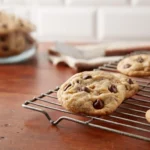Baking bread at home can seem like a daunting task, especially if you’ve never tried it before.
However, making homemade bread with simple ingredients is not only achievable but also incredibly rewarding.
Whether you’re an experienced baker or someone who’s just starting to experiment in the kitchen, this guide will walk you through the process of baking soft, fluffy, and delicious homemade bread with just a few basic ingredients.
The best part? You don’t need fancy equipment or complicated techniques to make a perfect loaf.
With only a few pantry staples, you can create bread that rivals any store-bought option.
In this article, you’ll find a step-by-step guide, tips, and tricks to help you bake bread that’s soft on the inside and crispy on the outside.
From the simple ingredients needed to the kneading, rising, and baking processes, we’ll cover everything you need to know to create your own homemade masterpiece.
So, why not give homemade bread a try? It’s an enjoyable and satisfying experience that fills your home with a delicious aroma.
And once you’ve tasted freshly baked bread, you’ll wonder why you ever settled for store-bought loaves!
Ingredients Needed for Homemade Bread
The beauty of homemade bread lies in its simplicity. You don’t need any specialized ingredients or equipment.
Here are the basic ingredients you’ll need to make a loaf of bread from scratch:
All-Purpose Flour
Flour is the main ingredient in bread making. You’ll need all-purpose flour to form the dough’s base.
This flour contains enough protein to create the gluten needed for structure and texture in the bread.
If you prefer a whole grain loaf, you can substitute whole wheat flour for some or all of the all-purpose flour.
Active Dry Yeast
Yeast is the leavening agent that makes bread rise. It converts sugars into carbon dioxide, which causes the dough to expand.
Active dry yeast is the most common yeast used in home baking. You’ll need one packet, which is about 2 ¼ teaspoons. Make sure the yeast is fresh to ensure a good rise.
Salt
Salt is essential for flavor and to control the yeast’s activity. Without salt, the dough would rise too quickly, leading to poor texture. It also enhances the bread’s flavor, making it taste delicious and balanced.
Sugar
Sugar is the food that yeast consumes to produce carbon dioxide and alcohol, helping the dough rise.
While not a large amount is needed, sugar also helps in browning the bread, giving it a golden crust.
If you prefer a more savory bread, you can reduce the sugar to a teaspoon or even omit it.
Water
Water is essential for activating the yeast and forming the dough.
The water should be warm (about 110°F), but not too hot, as it can kill the yeast. Warm water ensures that the yeast activates properly.
Olive Oil or Butter (Optional)
Olive oil or melted butter can be added to the dough to provide richness, moisture, and flavor.
If you prefer a slightly richer bread, this ingredient can be very helpful. However, this is entirely optional, and the bread will still turn out great without it.
Step-by-Step Guide to Making Homemade Bread

Now that you’ve gathered your ingredients, let’s dive into the detailed process of making your homemade bread.
Follow these simple steps, and you’ll have a fresh loaf ready in just a few hours!
Step 1: Activating the Yeast
The first step in making bread is activating the yeast. In a small bowl or measuring cup, combine 1 ¼ cups of warm water and 1 teaspoon of sugar.
Stir the sugar into the water to help the yeast dissolve. Then, sprinkle the yeast over the top of the water. Let it sit for about 5-10 minutes.
During this time, the yeast will begin to bubble and foam as it becomes active.
If your yeast doesn’t foam, it may be old or the water may have been too hot, which kills the yeast. If this happens, start again with fresh yeast and water at the correct temperature.
Step 2: Mixing the Dough
Once your yeast is activated, it’s time to mix the dough. In a large bowl, combine 3 ½ cups of all-purpose flour and 1 teaspoon of salt. Mix these dry ingredients together before making a well in the center.
Pour the activated yeast mixture into the well in the center of the flour. If you’re using olive oil or melted butter, add that as well. Stir the mixture with a spoon until it begins to form a dough.
Step 3: Kneading the Dough
Once the dough comes together, turn it out onto a clean, floured surface. Knead the dough for about 8-10 minutes, folding it over and pressing down with the heels of your hands.
This process helps develop the gluten, giving the bread structure and a chewy texture.
If the dough feels too sticky, sprinkle in a little extra flour.
Conversely, if it’s too dry, add a small amount of water, one tablespoon at a time. The dough should be smooth and elastic when it’s done.
Step 4: First Rise
After kneading the dough, place it in a lightly greased bowl. Turn the dough in the bowl to coat it lightly in oil.
Cover the bowl with a damp cloth or plastic wrap and let it rise in a warm place for 1-1.5 hours.
The dough should double in size during this time.
You can speed up the rising process by placing the bowl in a slightly warm oven (turned off) or near a warm window.
Make sure to check the dough halfway through to ensure it’s rising properly.
Step 5: Punching Down the Dough
Once the dough has doubled in size, it’s time to punch it down to release the air. Gently deflate the dough by pressing it with your fist.
This step is crucial because it helps redistribute the yeast and sugars, resulting in an even texture.
Step 6: Shaping the Dough
Now, shape the dough into your desired form. You can make it into a traditional loaf shape or divide the dough into smaller rolls.
If you’re making a loaf, roll the dough into a tight cylinder and tuck the ends underneath.
Place the shaped dough in a greased loaf pan or on a parchment-lined baking sheet, depending on your preference.
Cover the dough once again and let it rise for another 30-45 minutes until it puffs up.
Step 7: Preheating the Oven
As your dough rises, preheat your oven to 375°F (190°C).
This temperature is ideal for baking bread, allowing it to cook through while developing a nice, golden-brown crust.
Step 8: Baking the Bread
Once the dough has risen and your oven is preheated, it’s time to bake the bread. Place the loaf in the middle of the oven and bake for 25-30 minutes.
The bread is done when it’s golden brown on top and sounds hollow when tapped on the bottom.
If you like a crispier crust, you can place a small pan of water on the bottom rack of the oven to create steam. This helps the crust develop a perfect texture.
Step 9: Cooling the Bread
After baking, remove the bread from the oven and let it cool on a wire rack for at least 10 minutes before slicing.
This cooling period allows the bread to set, making it easier to cut without becoming too crumbly.
Tips and Tricks for Perfect Homemade Bread
While making bread at home is simple, a few tips can help you perfect your loaf:
Proper Yeast Activation
Always check the expiration date of your yeast. If it’s expired or not activated properly, your dough won’t rise as expected.
Be sure to use warm (not hot) water to activate the yeast, as water that’s too hot can kill it.
Adjust the Dough Consistency
The dough should be smooth and slightly sticky.
If it’s too dry, add a bit more water. If it’s too sticky, add flour gradually until the right texture is achieved.
Don’t Skip the Rising Time
The first and second rise are crucial for the bread’s texture. If you rush these steps, the bread may turn out dense and heavy. Be patient and let the dough rise until it has doubled in size.
Experiment with Add-ins
You can customize your bread by adding herbs, garlic, cheese, or even seeds like sunflower or sesame for added flavor. Simply incorporate these ingredients into the dough before the first rise.
Baking Temperature
If you prefer a softer crust, you can lower the oven temperature slightly to 350°F (175°C) and bake the bread a bit longer.
If you like a crispy crust, stick to the recommended temperature and try adding steam to the oven.
ALSO READ: How to Make Perfect Chocolate Chip Cookies Every Time
Conclusion
Making homemade bread is a simple and rewarding process. With just a few basic ingredients—flour, yeast, salt, sugar, and water—you can create a delicious loaf that rivals any store-bought option.
By following the steps outlined in this guide, you’ll be able to bake bread that is soft on the inside with a crispy, golden crust.
Whether you’re new to baking or a seasoned pro, this recipe is sure to become a favorite in your kitchen.
Once you’ve perfected the basic recipe, feel free to experiment with different flavors and add-ins to create a bread that suits your personal tastes.
Enjoy the process and the delicious result—fresh homemade bread that’s perfect for sandwiches, toasts, or simply with a dollop of butter!







